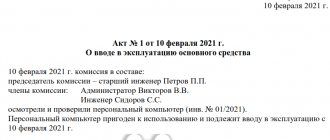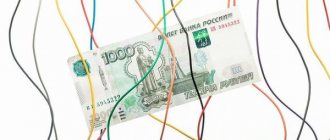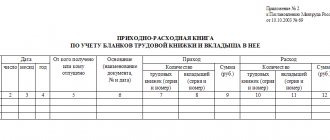What is work in progress?
This is a unique group of assets that no longer refers to materials, but also does not yet constitute a finished product. Accounting standards give them a clear definition. According to PBU, work in progress is products or work that have not passed all stages of the technological process, acceptance or testing. This also includes:
- incomplete products;
- unfulfilled orders;
- independently produced semi-finished products that are not classified as finished products;
- services and work not accepted by the customer;
- semi-finished products and processed materials;
- units, parts, assembly connections.
To account for the costs of the production process, active accounts 20–29 are used. Expenses are collected in debit, and they are written off (distributed) in credit. The balances on these accounts at the end of the month characterize the value of work in progress.
Work in progress in accounting
Work in progress is products that have not gone through all the stages provided for by the technological process.
There are different methods for assessing it, which depend on the technology that the company uses.
Read what exactly is considered work in progress, how to choose methods for assessing it, and how to take it into account in tax and accounting. See examples of calculations and accounting entries.
What is work in progress in accounting?
Work in progress (WIP) are goods or other products that have not yet been released at the reporting date, but the production cycle has already begun. The reporting date may be the last calendar day of the year. If monthly reporting is provided, then WIP is done on the last calendar day of each month.
https://www.youtube.com/watch?v=7F4AOdR9oVA
WIP includes:
- Released items that are not complete.
- Products that have not passed acceptance tests.
- Semi-finished products or other raw materials that have already been processed, but have not yet become finished products.
- Completed work not accepted by the customer.
The organization must independently choose a method for assessing work in progress based on its technology and consolidate it in the accounting policy for the current year. The choice of method is very important, since it determines the cost of manufactured products and affects the company’s income tax, and, as a consequence, the financial result of the organization for the reporting period.
Valuation of work in progress
If you have a piece production, reflect the work in progress on account 20 at actual costs. If mass or serial, use one of three methods for assessing work in progress:
Valuation method based on actual cost
The method is suitable for both mass and piece production. The cost of the product includes absolutely all costs associated with the production of products (direct, general and general production costs). This method is considered the most accurate.
Example 1
The company produces shampoo. Within a month, it launched 200,000 units of the product. In fact, 180,000 units of shampoo were produced and received into the warehouse as finished products, of which 150,000 pieces were sold to the buyer at a price of 32 rubles per piece. Let's assume that at the beginning of the month there is no work in progress or unsold shampoo in the warehouse.
We find that WIP at the end of the month is 20,000 units and unsold goods are 30,000 units. Costs for this month:
- raw materials and supplies – 1,000,000 rubles;
- salary and insurance contributions of production personnel = 2,000,000 rubles;
- depreciation of equipment – 500,000 rubles;
- general business and production expenses (for example, salaries of management personnel, depreciation of other equipment, etc.) amounted to 700,000 rubles.
The amount of actual costs was = 1,000,000 + 2,000,000 + 500,000 + 700,000 = 3,200,000 rubles.
Therefore, WIP at the end of the month will be = 3,200,000 rubles / 200,000 pieces * 20,000 pieces = 320,000 rubles.
Valuation method based on the cost of raw materials and semi-finished products
Used for short-term production cycles. Here, the cost of the product includes only the actual cost of raw materials. All other costs are included in the cost of finished products.
Example 2
The company makes packaged chocolate cupcakes. This month, 10,000 packages of cupcakes were sent to production; 9,800 packages were actually produced and received as finished products. Of which 9,500 products were sold at a price of 40 rubles per piece. Costs for materials amounted to 400,000 rubles. It should be noted that there is no work in progress at the beginning of the month.
We find that the WIP balance at the end of the month is 200 units and its calculation will be as follows:
WIP at the end of the month = 200 units x 40 rubles = 8,000 rubles.
The calculation can be done in another way:
- Share of work in progress in the total amount of products in production = 200 pieces / 10,000 units * 100% = 2%
- The share of raw materials and materials that are unfinished = 2% * 400,000 rubles = 8,000 rubles.
This method is considered accurate for material-intensive production, when the share of raw materials and supplies constitutes a significant portion (say, 80-90% of the total manufacturing costs) and there is no point in wasting time on calculating insignificant amounts of other costs. It is more logical and convenient to attribute other expense items directly to the cost of finished products. As a rule, this is typical for the food industry.
Valuation method based on direct cost items
Usually used in material-intensive production. The cost of production includes only production-related expenses, the list of which is directly provided for in the accounting policies of the organization. All other costs are included in the cost of finished products.
Example 3
The company is engaged in sewing children's clothing. 8,480 rubles were spent on the production of 100 pieces of children's vests, including:
- a piece of cotton fabric worth 3,000 rubles,
- salary of the worker who manufactured the products (including insurance premiums) – 5,000 rubles;
- depreciation of a sewing machine is 480 rubles.
At the beginning of the month, there were products worth 9,500 rubles in production. In a month, 100 vests were sewn and 70 were sold. WIP at the end of the month will be:
WIP = (8480 rubles / 100 units * 70 units) + 9500 rubles = 15436 rubles.
Valuation method based on standard cost
It is used more often in serial and mass production. The method is based on the use of standards to account for all production costs. During recalculation, deviations of actual costs from standard costs may occur. If standards change, it may be necessary to re-evaluate the work in progress at the beginning of the month.
Example 4
Let's look at the data in example 1. In order to use this method, you only need to know the total number of unfinished products at the end of the month and the standard cost established for production. For this example, let’s assume that the standard is 40 rubles.
Since the production of 20,000 bottles of shampoo at the end of the month has not been completed, the WIP should be estimated at 800,000 rubles (20,000 units x 40 rubles).
Transactions in accounting should be reflected with the following entries:
| Account debit | Account credit | operations |
| 43 | 40 | Products are capitalized as they are manufactured and received at the warehouse |
| 62 | 1 | Revenue from the sale of products is reflected |
| 1 | 43 | The standard cost of production has been written off |
| 51 | 62 | Received payment (prepayment) for shipped products |
| 40 | 20 | At the end of the month, the actual cost of production is written off |
| 1 | 40 | The difference between standard and actual costs is written off |
| 1 | 99 | The financial result from the sale of the product at the end of the month was identified and written off |
How to evaluate work in progress in management accounting
Sergey Shebek , project manager COSTKILLER.RU
When developing rules for assessing work in progress in management accounting, establish in the accounting policy how:
– evaluate it at the time of recognition (initial evaluation);
– update the cost;
– evaluate when transferred to production for further processing.
How to determine the value of an asset at the time of recognition and upon transfer to production, when and how to update it, how to evaluate work in progress in management accounting, read here.
Which account to account for?
Operations to account for work in progress are reflected in account 20 “Main production”. All expenses are collected in the debit of the account. At the end of the month, expenses included in the cost of finished products are written off on the credit of the account, and the accumulated amount of expenses for production that is not completed remains unwritten off on the debit of the account.
Account 20 accumulates all costs, both direct and indirect. Reflect this with the following entries:
| Account debit | Account credit | operations |
| Accounting for direct expenses | ||
| 20 | 10 | Reflected the cost of materials (raw materials, semi-finished products) written off for production |
| 20 | 70 | Wages accrued to workers directly involved in the production process |
| 20 | 69 | Insurance premiums of production personnel are reflected |
| 20 | 02 | Depreciation of the equipment used to produce the product is reflected. |
| Accounting for indirect costs | ||
| 25 | 10 | Write-off of materials for equipment repairs |
| 25 | 02 | Depreciation of general production equipment is reflected |
| 26 | 70 | Costs for remuneration of management personnel are reflected |
| 26 | 69 | Insurance premiums of management personnel are reflected |
| Product cost accounting | ||
| 20 | 25 | General production expenses written off at the end of the month |
| 20 | 26 | General business expenses written off at the end of the month |
| 43 | 20 | Finished products are received |
It should be understood that the costs accumulated on accounts 25 and 26 are written off to account 20 not all at once, but only in the part that relates to completed production processes. This is how the value of work in progress is formed at the end of the reporting period.
Tax accounting
The Tax Code of the Russian Federation also provides the concept of work in progress (Article 319). Thus, according to the Tax Code of the Russian Federation, the following are considered unfinished:
- partially finished goods and products;
- balances of unfulfilled orders;
- work not accepted by the customer that was completed on time;
- remnants of home-made semi-finished products;
- materials and raw materials (as well as semi-finished products) sent to production.
Work in progress at the end of the month is assessed taking into account data on the balances in quantitative terms of raw materials and supplies in production, as well as the amount of direct costs for this month. The amount of balances at the end of the month is included in the direct expenses of the next month. In this case, the following conditions must be observed:
- Production costs must be related to the type of product for which they are produced. If this is not possible, the organization independently develops a method for allocating costs to types of products.
- The method of allocating product costs should be fixed in the accounting policy for tax purposes.
- The selected method must be used for at least 2 tax periods.
conclusions
In work in progress, the organization includes the cost of materials, raw materials and semi-finished products that have not gone through all stages of production, as well as work not completed or not accepted by the customer. The amount of work in progress is determined at the end of the month according to the selected cost distribution method. The easiest method to calculate is based on the cost of raw materials and semi-finished products.
But in any case, when choosing a method for assessing work in progress, you should be guided not only by the ease of calculation, but also by other indicators, such as financial results, accuracy of asset valuation, etc.
The chosen method is described in the organization’s accounting policy and for tax accounting purposes a minimum of 2 tax periods is used (
Types of assessment
In accounting, data is reflected in natural and monetary measures. To accept or write off funds, you need to know their value. The assessment of work in progress is carried out using the following method:
- Actual costs incurred (for single production).
- Actual cost is the most reliable and common method. The volume of work in progress is determined. After which its quantity is multiplied by the average unit cost, thereby determining the actual production cost of all work in progress at the end of the month.
- Standard cost – applicable for serial and mass production of products. The accounting price per unit of work in progress is applied. Additionally, records are kept of deviations of the planned cost from the actual cost.
- For direct cost items - the price of a unit of work in progress is calculated by summing up the direct costs of its creation.
- WIP costs - the cost of work in progress includes only materials, raw materials or semi-finished products. The method is mainly used in material-intensive production.
The enterprise must choose the most appropriate method for assessing work in progress and write it down in its accounting policies. The balance of work in progress is assessed on the basis of primary documentation, and its size is determined after conducting an inventory at the end of the month.
Answers to common questions
Question No. 1: What should be taken as the basis for the purpose of distributing the company’s overhead costs?
Answer: The basis for the distribution of general production expenses must be approved by each enterprise independently and fixed in the accounting policy. The base can be:
- total revenue from sales of one type of product,
- total direct costs of producing each type of product,
- salaries of employees involved in the production of the product,
- the cost of materials spent on the production process of the product.
Question No. 2: How is the actual cost of auxiliary production products calculated?
Answer: Calculations are made based on the sum of direct costs of these productions and indirect costs in relation to the activities of production. The value of work in progress balances of auxiliary production is also taken into account. At the end of the month, the costs of auxiliary production are distributed among the consumer industries of the released products.
Products with a long production cycle
Industrial production sometimes produces products that go through several stages of processing. At the same time, enterprises can recognize the fact of sale at different points in time: at certain stages of the work or after its complete completion. Usually the second option is used.
If the products are delivered in stages, then there is a need to use account 46. The debit indicates the parts of the work paid for by the customer and completed by the enterprise. After all stages are completed, the cost of the object accumulated in account 46 is written off to the debit of the “Settlements with customers and buyers” account.
Features of accounting for shortages and losses
When reflecting shortages and damage, a number of rules must be taken into account.
Reflecting shortages
Shortages can only be recorded when they are discovered:
- when carrying out inventory;
- upon receipt of objects in volumes limited by the supply agreement.
On the DT account, the shortage is recorded in the following amounts:
- Real cost if the values cannot be restored or do not exist at all.
- Residual value, if the question concerns fixed assets that are out of order or missing.
- Real losses if partial damage occurs.
That is, the accounting amount is determined depending on the specific circumstances.
Write-off
The write-off is carried out on CT account 94 . In the process, they are included in the cost structure. They can be written off as other expenses. In this case, this wiring is performed: DT91/2 KT94. The entry is relevant when the amount of losses exceeds the norms of natural profit. If the person responsible for causing the damage is found, recovery occurs. In this case, the following wiring is relevant: DT73/2 KT94. If a shortage is detected within the EU boundaries, it is written off at the expense of cost. Record used: DT20, 44 KT94.
If a shortage is discovered upon acceptance of goods and materials, it makes sense to act on the basis of the provisions of the agreement. The agreement, as a rule, stipulates the maximum amount of shortages. If losses are made within these values, they are reflected in account 94. If the amount of shortfalls exceeds the acceptable limits, account 76 is used.
Sometimes losses are discovered long after the actual incident in which the damage or shortage occurred. It is assumed that the fact of loss was not recorded in previously conducted inventories. If the culprit of the incident is found and the amount of damage is recovered from him, this entry is made: DT94 KT98/3. After the guilty party has paid compensation, it is written off as other expenses. If a person denies his guilt and does not want to compensate for the damage, entries in account 94 are not made until a court ruling. If damage occurred as a result of an emergency, this entry is relevant: DT99 KT94.
IMPORTANT! If stolen valuables are written off, the VAT on them, accepted for deduction, is restored.
Organization of WIP inventory
The specifics of the inventory are indicated in the accounting policy of the enterprise. With the exception of mandatory inspections, the following organizational issues are established regarding the planned calculation of the number of assets:
- list of property subject to the procedure;
- the total number of inventories that are planned to be carried out in the reporting period and their dates;
- composition of commissions;
- other information.
Mandatory inventory of work in progress is carried out in the event of damage or theft of work items in its composition, a change in responsible persons, and some other cases.
Regardless of the reasons for conducting the inspection, the process is carried out in accordance with the instructions of the Ministry of Finance (order No. 49). First of all, the manager issues and signs an order that contains information about:
- reasons for conducting the inspection;
- groups of property falling under the process;
- the composition of the commission participating in the inventory;
- start and end date;
- the period within which documents must be submitted to the accounting department.
The order is a kind of task for the inventory commission. It consists of accounting employees, administrative employees, and other specialists. A prerequisite is the presence of financially responsible persons. Representatives of an independent audit service may also be involved. The presence of each member of the commission is mandatory, otherwise the results of the inspection are considered invalid.
Postings for writing off work in progress
Below are the entries for writing off expenses for work in progress in core activities. Postings for the organization’s auxiliary activities are generated in the same way.
| Account Debit | Account Credit | Description | Sum | A document base |
| 20.01 | 60.01 | Third-party company services | Cost of services | Certificate of completion of work, Invoice (received) |
| 20.01 | 10.01 | Material consumption for main production | Cost of materials | Requirement-invoice, Limit-fence card |
| 20.01 | Accrued wages to employees | Accrued salary | Accounting certificate-calculation | |
| 20.01 | 69.01 | Insurance premiums for employees | Insurance premiums | Accounting certificate-calculation |
| 20.01 | 71.01 | Travel expenses | Travel allowance amount | Advance report |
| 20.01 | 97.21 | Deferred expenses for this production | Amount of deferred expenses | Accounting certificate-calculation |
| 20.01 | Deficiencies of MPZ within normal limits | Cost of shortage | Inventory list, Accounting certificate-calculation | |
| 20.01 | 02.01 | Depreciation by fixed assets | Depreciation deductions | Accounting certificate-calculation |
Procedure for carrying out inventory of work in progress
The chairman of the commission puts visas “Before inventory on date n” on all expenditure and receipt documents received for inventory. This is necessary to record data on property balances before starting the inspection. Financially responsible persons provide receipts stating that all primary documents have been submitted, incoming property has been capitalized, and disposed property has been written off as expense. After which an inventory of work in progress can be carried out.
They begin to calculate the actual availability of property. Information about its quantity is recorded in acts or inventories, which are compiled in at least two copies. The document is numbered, it indicates the date of the inspection, the date and number of the management order on its organization. Next, tables are compiled for each workshop and the location of work in progress objects. Once completed, the document is signed by members of the commission and financially responsible persons. The latter additionally provide a receipt stating that the verified volume of work in progress has been accepted for safekeeping.
Typical entries for inventory of work in progress
When conducting an inventory, the commission can receive several results, and for each of them the corresponding entries are generated. The most common ones are:
- if a surplus of work in progress items is identified
Debit 20 Credit 91/1 market value of surplus accepted for accounting
- if a shortage is identified
Debit 94 Credit 20 reflects the cost of the shortage
- shortages according to the norm and in excess of it are allocated to different accounts
Debit 20 Credit 94 shortage within normal limits attributed to production
Debit 73 Credit 94 shortage in excess of the norm is attributed to the culprit, if he is identified
Debit 91/2 Credit 94 shortfall in excess of the norm is charged to other expenses if the culprit is not identified
Inventory of unfinished construction
Inspection of capital construction projects is carried out for each structural element, type of work, equipment and its other components. In this case, the commission needs to find out:
- whether the WIP includes objects transferred for installation work, but not yet affected by them;
- what is the condition of the objects under conservation and the construction of which has been temporarily stopped.
Separate acts are drawn up for buildings that have been put into operation but not properly accepted. A similar measure is applied to objects whose delivery deadline has been delayed for some reason.
Results
The following can be said about work in progress in accounting: these are material costs that have already gone into production, but have not yet gone through all stages of the production process, and therefore cannot be considered finished products.
The value of work in progress balances can be assessed using one of several methods, which must be enshrined in the accounting policies of the enterprise. You can find more complete information on the topic in ConsultantPlus. Free trial access to the system for 2 days.
WIP inventory and industrial production
At enterprises of this type, the commission checks the availability of all materials, raw materials, as well as the completeness of units, reserves and installations. All unnecessary inventories are handed over from the workshop to the warehouse before inventory. For each separate division, an act or inventory is drawn up. Separate documentation is required for raw materials, materials and semi-finished products that have not been processed, but were located near workplaces. The WIP inventory does not include rejected items.
An inventory of work in progress at an industrial enterprise is carried out in order to check:
- availability of reserves, units, components, parts;
- quantity of unfinished products;
- completeness of units, components, parts;
- WIP balances for orders whose execution has been canceled or suspended.
Backlogs, components, assemblies and parts are counted, measured and weighed. The data is entered into the relevant acts or inventories.
Work in progress at an enterprise, which is a mixture of different raw materials or a heterogeneous mass, is characterized using two indicators: the total quantity and the portion attributable to each item in its composition. The calculation procedure is regulated by industry instructions, and in their absence, it is prescribed in the accounting policy.
The purpose and objectives of inventory of work in progress
The main purpose of the inventory of work in progress is considered to be to determine the actual presence of objects of work in progress, identifying unaccounted for defects, determining the completeness of products, determining the balances of canceled or suspended orders and calculating the cost of products that are in the stage of work in progress. In addition, the purpose of the inventory is to compare actual data with accounting indicators and identify factors influencing discrepancies in information.
In accordance with the goal, the following tasks should be solved during the inventory of work in progress:
- determination of the composition, structure and quantity of work in progress;
- drawing up inventory lists that will contain all the necessary information, including the name of the object or product, its quantity, degree of readiness and completeness, stage of production;
- identifying unaccounted for defects in production and determining its percentage of manufactured products;
- study and analysis of maps for the release of materials into production in order to identify the irrational use of the enterprise’s material resources;
- calculation of the cost of work in progress according to the method specified in the accounting policy and used in the organization.
Reflection of inventory results
Acts and inventories of inspections are submitted within the prescribed period to the accounting department. Inconsistencies discovered during the inventory between the data of primary documents and the actual availability of property must be reflected in the accounting accounts.
If excess work in progress is discovered, it should be capitalized at market value on the date of the inspection. Work in progress in accounting is listed on accounts 20–29. The amount is recorded in the debit of the account in which the surplus was discovered: Dt “Auxiliary production” Ct “Other income”.
Shortages or damage to work in progress are shown in the credit of production cost accounts. The accounting entries look like this: Dt “Shortages” Cht “Main production”, Dr. “Losses from damage to valuables” Cht “Main production”. If the detected shortage does not exceed the norm of natural loss, then its amount is attributed to distribution costs: Dr. “Main production” Ch. “Shortages”. Such write-off is carried out on the basis of the calculation recommended by the accounting policy.
Legislative acts on the topic
Legislative acts are represented by the following documents:
| clause 20 PBU 4/99 | On the reflection of work in progress in the balance sheet asset on the line “Inventories” |
| clause 64 of Order of the Ministry of Finance dated July 29, 1998 No. 34n | About options for assessing work in progress |
| Order of the Ministry of Finance of the Russian Federation dated October 31, 2000 No. 94n | On the collection of costs of main production according to the debit of account 20 “Main production” |
| clause 204 of the Guidelines for accounting of inventories (approved by Order of the Ministry of Finance of the Russian Federation dated December 28, 2001 No. 119n) | On the application of discount prices for finished and intermediate products |
Reflection of shortages in excess of established standards
The accounting policy of an enterprise establishes certain standards, including a portion of property losses that are considered acceptable. In cases where the shortage occurs due to damage to the work in progress, there are two options for reflecting the results in accounting:
- If the culprits are identified, the shortage is restored at their expense. The accounting entries are as follows: Dt “Calculations for compensation of damage” Ct “Shortages”, Dt “Calculations for compensation of damage” Ct “Losses from damage to valuables”.
- If the court refuses to recover damages from the guilty parties, or they are not identified, then the shortfall is written off to the financial result: Dr. “Other expenses” Ch. “Shortages”.
- If property damage occurred due to an emergency or force majeure, then the procedure for reflecting losses is similar to clause 2.
Amounts of shortages in excess of the norm oblige the inventory commission to conduct an internal investigation in order to identify the perpetrators.
Work in progress in accounting occupies a special place in the assets of the enterprise. These are no longer raw materials and materials, but also not finished products. Controlling its quantity is as important as for any other property. In order to compare the data of primary documents with the actual availability of work in progress, inventories are carried out, as a result of which the indicators are adjusted, if necessary.
Accountant's Directory
To do this, use the formulas: Equivalent quantity of finished products at the first stage of the production process = Remains of raw materials not processed (partially processed) at the first stage of the production process (in natural meters) × Product readiness coefficient at the first stage of production Equivalent quantity of finished products at the second stage of production process = Remains of raw materials not processed (partially processed) at the second stage of the production process (in natural measures) × Product readiness coefficient at the second stage of production Equivalent quantity of finished products at the end of the reporting period = Equivalent quantity of finished products at the first stage of the production process + Equivalent quantity finished products at the second stage of the production process + etc.
How to calculate the change in the balance of work in progress of finished goods
According to technological standards, 80 units of products should be produced from this amount of raw materials (800 pcs.: 10 pcs./unit). As of April 30, 65 mink coats were delivered to the finished products warehouse. Master's direct costs for production in April were:
- cost of consumed raw materials and materials - 800,000 rubles;
- salary of production workers (including contributions accrued from it for compulsory pension (social, medical) insurance and insurance against accidents and occupational diseases) - 154,000 rubles.
The amount of general production expenses is 42,000 rubles. The amount of general business expenses is 56,000 rubles. In April, the following entries were made in the Master’s accounting: Debit 20 Credit 10–900,000 rub. – materials for the production of fur coats were written off; Debit 20 Credit 70 (69)– 154,000 rub.
Valuation of work in progress balances
For the amount of general production and general economic expenses 20 25 (26) At the time of estimating the cost of products of the main production 40 20 When estimating the cost of services 90 (account) 20 Formation of cost per account.
20 In terms of the cost of external supplier services 20 60 In terms of the cost of purchasing materials for the main production 20 10 In terms of the salary of employees of the main workshop 20 70 In terms of the amount of payments to funds from the main earnings 20 69 In the amount of expenses for the main business trip 20 71 In terms of size costs of future periods 20 97 As part of the shortage identified during inventory work 20 94 For the amount of depreciation accrued for the current month 20 02 Accounting for costs in work in progress: accounting entries Volumes of work in progress are not turnover in accounts, this is the account balance. 20, its cut for a specific date.
Lines 5670
It is necessary to add direct costs for the balance of shipped products at the beginning of the month with direct costs distributed over the cost of shipped finished products during the month, and from the resulting result subtract direct costs for products sold during the month.6 Enterprises that provide services can assign direct costs to fully to reduce income from sales or production. Lines 5670 For more information on this, see:
- How to reflect the costs of auxiliary production in accounting;
- How to reflect the expenses of service industries and farms in accounting.
The cost of balances of raw materials and materials not written off to the cost of finished products (work performed) (debit balance on accounts 20, 23 and 29 at the end of the reporting period) is recognized as the cost of work in progress.
Accounting and evaluation of work in progress: postings
Attention
Sales") only after the parties sign the act of provision of services. Until this act is executed, the entire amount of expenses accumulated on account 20 for this service will form the cost of work in progress.
Regardless of the nature of the services provided (short-term or long-term), in tax accounting, performing organizations have the right to write off direct costs as expenses of the current reporting period without allocation to work in progress (clause.
2 tbsp. 318
Tax Code of the Russian Federation). In this regard, in the second case, discrepancies in the accounting procedure for expenses will lead to temporary differences. In this regard, it will be necessary to reflect the deferred tax liability in accounting. This conclusion follows from the provisions of paragraphs 10, 15, 18 of PBU 18/02.
Vi change in work in progress balances
Important
The entire amount of average balances of work in progress at the end of the month is included in the direct expenses of the next month.
Work in progress in accounting
3 Assessment of work in progress is carried out at standard or actual cost, direct costs, cost of raw materials and materials. The procedure must be established by the accounting policy of the enterprise. All enterprises evaluate average warehouse balances in the same way, which is independent of the specifics and type of activity and is prescribed in the Tax Code.
4 The accountant, based on data on direct costs attributable to the warehouse balance of finished products at the beginning and end of the month, as well as on the basis of information on direct costs on products produced during the month, calculates the average warehouse balance. There are several methods for estimating work in progress balances:
- At actual cost (the method is applied to finished products). Most often, this method is used in individual (single) production.
- At standard cost (planned). The method is convenient for mass and serial production, to which the method of estimation in the amount of direct costs is equally applicable, when the remaining indirect costs are included in the cost of finished products.
- By the amount of direct costs. In such situations, it is allowed to transfer direct costs solely to the price of materials, raw materials, and semi-finished products.
- At the cost of materials, semi-finished products and raw materials used to produce products.
At the time of transfer of work in progress balances to the buyer, make the following entry: Debit 91-2 Credit 20 – the actual cost of work in progress balances is written off.
Document the transfer of property accounted for as part of work in progress in an act (Article 556 of the Civil Code of the Russian Federation).
When calculating income tax, the amount received from the sale of property accounted for as part of work in progress balances should be reflected in income from sales in the amount of the contract value excluding VAT (clause
1 tbsp. 248, paragraph 1, art. 249 of the Tax Code of the Russian Federation). And the costs associated with the creation of property and its sale should be included in expenses (subclause 2, clause 1, article 268 of the Tax Code of the Russian Federation).
Sales of property, including those accounted for as part of work in progress, are recognized as subject to VAT (subclause 1, clause 1, article 146 and clause 3, article 38 of the Tax Code of the Russian Federation). A4.
Master's accounting policy provides for the assessment of work in progress at the cost of raw materials, materials and semi-finished products. Cost accounting is carried out using account 40. In April, 20 cubic meters were transferred to production. m of wood with a total cost of 110,000 rubles. (without VAT).
The cost of one cubic meter of wood is 5,500 rubles per cubic meter.
m. According to the results of the inventory as of April 30, wood remains were identified in the production shops - 2 cubic meters. m. Direct costs amounted to 203,906 rubles, including:
- cost of materials used – 110,000 rubles;
- salary of production workers - 74,000 rubles;
- the amount of contributions for compulsory pension (social, medical) insurance and contributions for insurance against accidents and occupational diseases from the salaries of production workers is 19,906 rubles.
The amount of indirect expenses for the month amounted to 138,000 rubles.
The total amount of the organization's expenses for the month amounted to 341,906 rubles. (RUB 203,906 + RUB 138,000). The following entries were made in the Master's accounting: Debit 20 Credit 10 (25, 26, 68, 69, 70...) – 341,906 rubles.
– paper production costs are taken into account; Debit 40 Credit 20– 330,906 rub. (110,000 rubles: 20 cubic meters × 18 cubic meters + 74,000 rubles +19,906 rubles + 138,000 rubles) – reflects the actual cost of manufactured products.
The cost of work in progress remains: RUB 341,906.
– 330,906 rub. = 11,000 rub. This difference represents the balance in account 20 at the end of April. Valuation by direct costs When applying the method of estimating work in progress by direct cost items, distribute direct costs between the balances of work in progress and finished goods in the same manner as is used to calculate income tax. For more information, see
The concept of work in progress in accounting
The organization combines the simplified tax system and UTII. Taxation of the transaction for the sale of an object is carried out within the framework of the simplified tax system
An organization that combines the simplified tax system (income) and UTII sells an unfinished non-residential building that was not put into operation, was not included in fixed assets, and was not used in business activities.
Source: https://1atc.ru/nezavershennoe-proizvodstvo/








